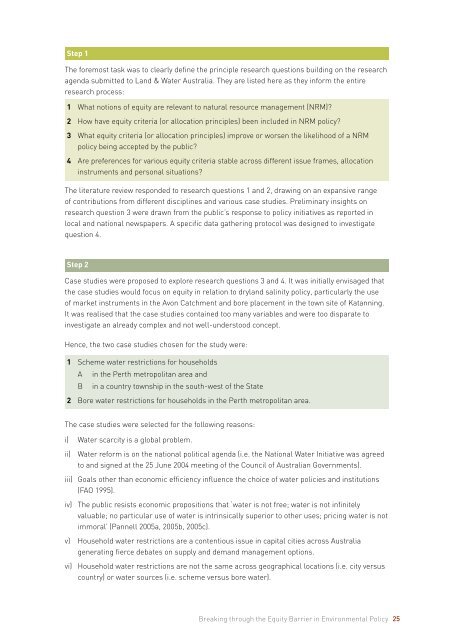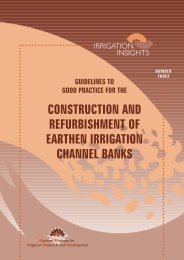Final Report Breaking through the Equity Barrier in Environmental ...
Final Report Breaking through the Equity Barrier in Environmental ...
Final Report Breaking through the Equity Barrier in Environmental ...
- No tags were found...
You also want an ePaper? Increase the reach of your titles
YUMPU automatically turns print PDFs into web optimized ePapers that Google loves.
Step 1<br />
The foremost task was to clearly def<strong>in</strong>e <strong>the</strong> pr<strong>in</strong>ciple research questions build<strong>in</strong>g on <strong>the</strong> research<br />
agenda submitted to Land & Water Australia. They are listed here as <strong>the</strong>y <strong>in</strong>form <strong>the</strong> entire<br />
research process:<br />
1 What notions of equity are relevant to natural resource management (NRM)<br />
2 How have equity criteria (or allocation pr<strong>in</strong>ciples) been <strong>in</strong>cluded <strong>in</strong> NRM policy<br />
3 What equity criteria (or allocation pr<strong>in</strong>ciples) improve or worsen <strong>the</strong> likelihood of a NRM<br />
policy be<strong>in</strong>g accepted by <strong>the</strong> public<br />
4 Are preferences for various equity criteria stable across different issue frames, allocation<br />
<strong>in</strong>struments and personal situations<br />
The literature review responded to research questions 1 and 2, draw<strong>in</strong>g on an expansive range<br />
of contributions from different discipl<strong>in</strong>es and various case studies. Prelim<strong>in</strong>ary <strong>in</strong>sights on<br />
research question 3 were drawn from <strong>the</strong> public’s response to policy <strong>in</strong>itiatives as reported <strong>in</strong><br />
local and national newspapers. A specific data ga<strong>the</strong>r<strong>in</strong>g protocol was designed to <strong>in</strong>vestigate<br />
question 4.<br />
Step 2<br />
Case studies were proposed to explore research questions 3 and 4. It was <strong>in</strong>itially envisaged that<br />
<strong>the</strong> case studies would focus on equity <strong>in</strong> relation to dryland sal<strong>in</strong>ity policy, particularly <strong>the</strong> use<br />
of market <strong>in</strong>struments <strong>in</strong> <strong>the</strong> Avon Catchment and bore placement <strong>in</strong> <strong>the</strong> town site of Katann<strong>in</strong>g.<br />
It was realised that <strong>the</strong> case studies conta<strong>in</strong>ed too many variables and were too disparate to<br />
<strong>in</strong>vestigate an already complex and not well-understood concept.<br />
Hence, <strong>the</strong> two case studies chosen for <strong>the</strong> study were:<br />
1 Scheme water restrictions for households<br />
A <strong>in</strong> <strong>the</strong> Perth metropolitan area and<br />
B <strong>in</strong> a country township <strong>in</strong> <strong>the</strong> south-west of <strong>the</strong> State<br />
2 Bore water restrictions for households <strong>in</strong> <strong>the</strong> Perth metropolitan area.<br />
The case studies were selected for <strong>the</strong> follow<strong>in</strong>g reasons:<br />
i) Water scarcity is a global problem.<br />
ii) Water reform is on <strong>the</strong> national political agenda (i.e. <strong>the</strong> National Water Initiative was agreed<br />
to and signed at <strong>the</strong> 25 June 2004 meet<strong>in</strong>g of <strong>the</strong> Council of Australian Governments).<br />
iii) Goals o<strong>the</strong>r than economic efficiency <strong>in</strong>fluence <strong>the</strong> choice of water policies and <strong>in</strong>stitutions<br />
(FAO 1995).<br />
iv) The public resists economic propositions that ‘water is not free; water is not <strong>in</strong>f<strong>in</strong>itely<br />
valuable; no particular use of water is <strong>in</strong>tr<strong>in</strong>sically superior to o<strong>the</strong>r uses; pric<strong>in</strong>g water is not<br />
immoral’ (Pannell 2005a, 2005b, 2005c).<br />
v) Household water restrictions are a contentious issue <strong>in</strong> capital cities across Australia<br />
generat<strong>in</strong>g fierce debates on supply and demand management options.<br />
vi) Household water restrictions are not <strong>the</strong> same across geographical locations (i.e. city versus<br />
country) or water sources (i.e. scheme versus bore water).<br />
<strong>Break<strong>in</strong>g</strong> <strong>through</strong> <strong>the</strong> <strong>Equity</strong> <strong>Barrier</strong> <strong>in</strong> <strong>Environmental</strong> Policy 25
















